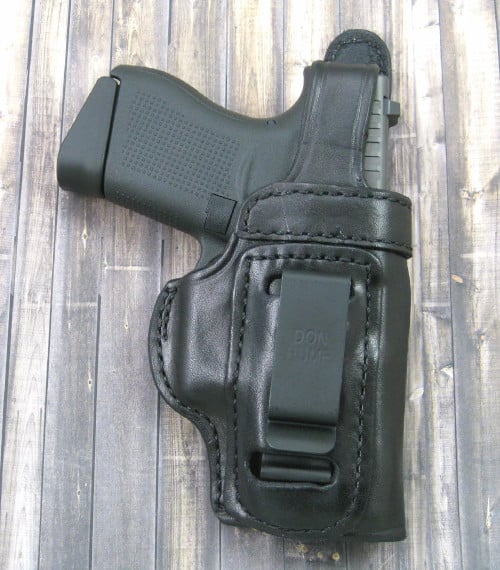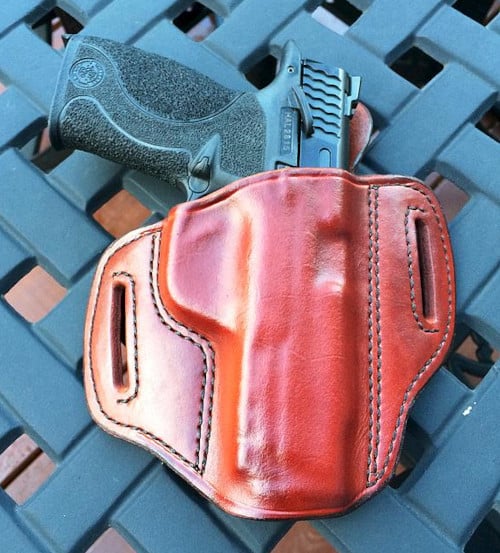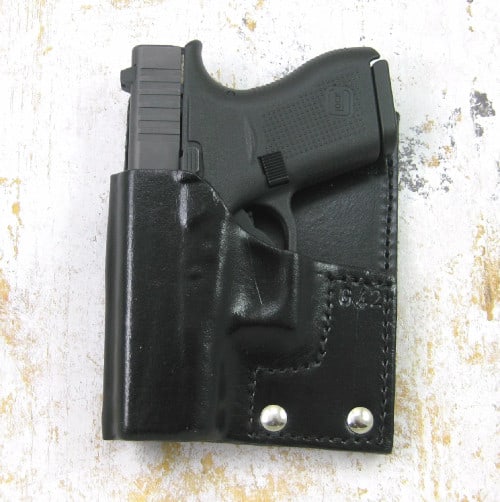As you shop for a gun holster, you will undoubtedly come across advertisements in gun magazines and videos on the internet advertising some type of IWB holster as the “ultimate” in concealment or concealed carry. Unfortunately, while the IWB holster in question may be a very effective way to carry a concealed handgun, it may not be a good choice for you.

Why? The answer is actually pretty simple: body type. Let’s face it, not everyone who carries a handgun concealed or for self-defense has the body type to make an IWB holster work. However, there are plenty of people (like me) with some spare area around the mid-section who may find that IWB holsters are:
- Not comfortable – Comfort is everything in concealed carry. Show me an uncomfortable holster, and I’ll show you one that doesn’t get used.
- Not concealable – As the name implies, IWB holsters are worn inside the pants. For certain body types, even an IWB holster simply won’t conceal at all. A key feature with IWB holsters involves the bulk of the weapon being carried inside the pants while the butt or grip remains above the waistline for access. If you have a “thick” waist, you really can’t conceal the weapon because the spare tire mid-section pushes the grip away from your body.
At the same time, some skinny people simply don’t have enough girth to conceal an IWB holster as well. So carrying the holster inside the pants isn’t an issue; the problem comes in keeping the weapon and holster concealed.
If you fall into this category, what are your alternatives? Well, you have a few:
Belt Holster
While the handgun size will play a role in both IWB and OWB carry, a smaller handgun can usually be concealed reasonably well using a high riding belt holster. Additionally, while it may not be invisible, you can get by with a loose-fitting, long shirt.

Again, this is an area where the pistol or revolver size will directly impact the effectiveness of proper concealed carry with a belt holster. The smaller the handgun, the easier it will be to hide, and the number of potential concealed carry methods goes up as well.
The ideal belt holster for those that are a bit wider than others will be a high riding model. The higher-riding, the better, as the added ride height reduces the possibility of the bottom portion of the holster sticking out under a shirt.
Pocket Holster
As the quality, performance, and reliability of pocket guns have improved over the last 20 or so years, the popularity of pocket carry has been on the rise.
A pocket holster can be an excellent concealed carry option for those who don’t have the body type to carry IWB. I’m in this group myself, and front pocket carry has become one of my all-time favorite daily CCW methods.

However, pocket holsters only work when the following criteria are met:
- The appropriately size pistol or revolver is selected for use
- You’re willing to dedicate a front pocket or back pocket solely for use with a pocket holster
The single most common reason for pocket carry not working for someone is because they are trying to carry a handgun that is too big for a pocket.
Most people carrying a concealed weapon are looking for the ideal blend of power (which is the caliber) coupled with round capacity. I feel the same way and would prefer to carry a pistol that is a 9mm or up and holds at least ten rounds. However, finding a pistol that meets those criteria and hides in my front pocket has proven nearly impossible.
You’ll most likely have to find a happy medium between caliber, round capacity, and overall size for successful pocket carry. I find that pistols like the Glock 26, Sig P365, and Springfield Hellcat are just a little bit too large to conceal in the average-sized front pocket and are challenging to draw due to their size. I’ve tried out nearly every so-called “pocket gun” on the market and settled on a Kahr P380 as it met most of my needs. While the .380 isn’t quite as powerful as a 9mm, with the right self-defense ammunition, it will suffice for me as a close-quarters self-defense caliber.
Ankle Holster
I’ve always seen ankle carry as one of the most underused carrying methods. Yes, it requires the use of long pants, and yes, it’s not the quickest way to draw a weapon. However, it’s still a viable alternative holster option if you can’t make IWB carry work.
Again, handgun or revolver size plays a role in ankle carry effectiveness, but that’s a common limitation on most handguns for CCW. I can carry a small .38 revolver on my ankle under my khakis, and no one can tell. Now, five shots of .38 Special isn’t all that much firepower by today’s standard, but it certainly beats not carrying anything at all.
Since drawing from an ankle holster requires some practice and requires the shooter to kneel down, ankle carry may not be a good option for someone with knee, ankle, or hip issues.
If you don’t have the body type to carry IWB, it’s not the end of the world in terms of carrying a concealed weapon. You may have to make some adjustments, but it can certainly be done.